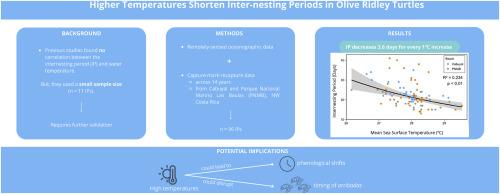Higher temperatures shorten inter-nesting periods in olive ridley turtles
IF 2.9
2区 生物学
Q2 BIOLOGY
引用次数: 0
Abstract
Climate change is impacting sea turtles worldwide with the effects varying between species and populations. For example, rising temperatures have variable effects on the duration of the inter-nesting period (IP)—the time between two consecutive nests during a single nesting season. Specifically, a negative correlation between water temperature and IP has been reported in green (Chelonia mydas), hawksbill (Eretmochelys imbricata), and loggerhead (Caretta caretta) turtles. In contrast, previous studies have shown no correlation for olive ridley turtles (Lepidochelys olivacea). Here, we assessed whether this lack of a correlation in olive ridley turtles was a product of the small sample size used in previous studies (nmax = 11). We used capture-mark-recapture data over 14 years to calculate the IP of olive ridley turtles (n = 96) nesting on two different beaches in Costa Rica. Next, we calculated mean sea surface temperature (SST) during each IP within estimated inter-nesting areas (225 km2), as inferred from previous olive ridley telemetry studies, and using data from NASA's multi-scale ultra-high-resolution sensor. Mean (±SD) IP was 22.5 ± 6.0 d (range: 13–41 d) and mean SST was 28.0 ± 0.6 °C (range: 26.1–29.5 °C). We observed a statistically significant negative relationship between SST and IP suggesting that elevated temperatures at inter-nesting habitats influence the phenology of olive ridley turtles as previously observed in other hard-shelled sea turtle species. Thus, we postulate that elevated temperatures due to climate change may influence the timing of nesting seasons for solitary nesting olive ridley turtles and may even alter timing of the olive ridley mass nesting aggregations known as arribadas.

较高的温度缩短了橄榄蠵龟的筑巢间隔时间
气候变化正在影响世界各地的海龟,其影响因物种和种群而异。例如,不断上升的温度对巢间期(IP)的持续时间有不同的影响,即在一个筑巢季节中两个连续巢穴之间的时间。具体来说,在绿海龟(Chelonia mydas)、玳瑁(Eretmochelys imbricata)和红海龟(Caretta Caretta)中,水温与IP呈负相关。相比之下,以前的研究表明橄榄蠵龟(Lepidochelys olivacea)没有相关性。在这里,我们评估了橄榄蠵龟缺乏相关性是否是先前研究中使用的小样本量的结果(nmax = 11)。我们使用了超过14年的捕获-标记-再捕获数据来计算哥斯达黎加两个不同海滩上筑巢的榄蠵龟(n = 96)的IP。接下来,根据之前的olive ridley遥测研究和NASA多尺度超高分辨率传感器的数据,我们计算了估计嵌套区域(225平方公里)内每个IP期间的平均海面温度(SST)。平均(±SD) IP为22.5±6.0 d(范围:13-41 d),平均海温为28.0±0.6°C(范围:26.1-29.5°C)。我们观察到海温与IP呈显著负相关,这表明巢间栖息地温度升高会影响榄蠵龟的物候,这与之前在其他硬壳海龟物种中观察到的情况相同。因此,我们假设气候变化导致的温度升高可能会影响独居橄榄蠵龟筑巢季节的时间,甚至可能改变橄榄蠵龟大规模筑巢聚集的时间。
本文章由计算机程序翻译,如有差异,请以英文原文为准。
求助全文
约1分钟内获得全文
求助全文
来源期刊

Journal of thermal biology
生物-动物学
CiteScore
5.30
自引率
7.40%
发文量
196
审稿时长
14.5 weeks
期刊介绍:
The Journal of Thermal Biology publishes articles that advance our knowledge on the ways and mechanisms through which temperature affects man and animals. This includes studies of their responses to these effects and on the ecological consequences. Directly relevant to this theme are:
• The mechanisms of thermal limitation, heat and cold injury, and the resistance of organisms to extremes of temperature
• The mechanisms involved in acclimation, acclimatization and evolutionary adaptation to temperature
• Mechanisms underlying the patterns of hibernation, torpor, dormancy, aestivation and diapause
• Effects of temperature on reproduction and development, growth, ageing and life-span
• Studies on modelling heat transfer between organisms and their environment
• The contributions of temperature to effects of climate change on animal species and man
• Studies of conservation biology and physiology related to temperature
• Behavioural and physiological regulation of body temperature including its pathophysiology and fever
• Medical applications of hypo- and hyperthermia
Article types:
• Original articles
• Review articles
 求助内容:
求助内容: 应助结果提醒方式:
应助结果提醒方式:


